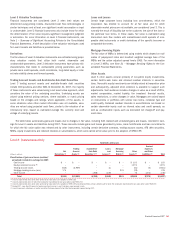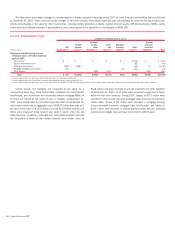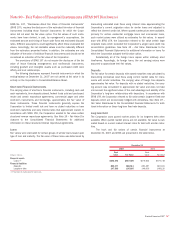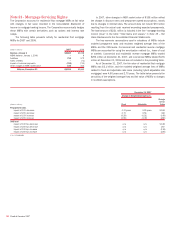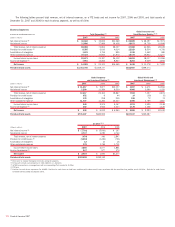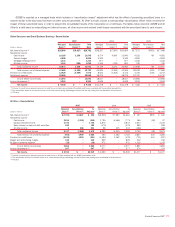Bank of America 2007 Annual Report Download - page 171
Download and view the complete annual report
Please find page 171 of the 2007 Bank of America annual report below. You can navigate through the pages in the report by either clicking on the pages listed below, or by using the keyword search tool below to find specific information within the annual report.Note 22 – Business Segment Information
The Corporation reports the results of its operations through three busi-
ness segments: Global Consumer and Small Business Banking (GCSBB),
Global Corporate and Investment Banking (GCIB) and Global Wealth and
Investment Management (GWIM). The Corporation may periodically
reclassify business segment results based on modifications to its
management reporting methodologies and changes in organizational
alignment.
Global Consumer and Small Business Banking
GCSBB provides a diversified range of products and services to individuals
and small businesses. The Corporation reports GCSBB’s results, specifi-
cally credit card, business card and certain unsecured lending portfolios,
on a managed basis. This basis of presentation excludes the Corpo-
ration’s securitized mortgage and home equity portfolios for which the
Corporation retains servicing. Reporting on a managed basis is consistent
with the way that management evaluates the results of GCSBB. Managed
basis assumes that securitized loans were not sold and presents earnings
on these loans in a manner similar to the way loans that have not been
sold (i.e., held loans) are presented. Loan securitization is an alternative
funding process that is used by the Corporation to diversify funding sour-
ces. Loan securitization removes loans from the Consolidated Balance
Sheet through the sale of loans to an off-balance sheet QSPE which is
excluded from the Corporation’s Consolidated Financial Statements in
accordance with GAAP.
The performance of the managed portfolio is important in under-
standing GCSBB’s results as it demonstrates the results of the entire
portfolio serviced by the business. Securitized loans continue to be serv-
iced by the business and are subject to the same underwriting standards
and ongoing monitoring as held loans. In addition, retained excess servic-
ing income is exposed to similar credit risk and repricing of interest rates
as held loans. GCSBB’s managed income statement line items differ from
a held basis as follows:
ŠManaged net interest income includes GCSBB’s net interest income on
held loans and interest income on the securitized loans less the
internal funds transfer pricing allocation related to securitized loans.
ŠManaged noninterest income includes GCSBB’s noninterest income on
a held basis less the reclassification of certain components of card
income (e.g., excess servicing income) to record managed net interest
income and provision for credit losses. Noninterest income, both on a
held and managed basis, also includes the impact of adjustments to
the interest-only strip that are recorded in card income as management
continues to manage this impact within GCSBB.
ŠProvision for credit losses represents the provision for credit losses on
held loans combined with realized credit losses associated with the
securitized loan portfolio.
Global Corporate and Investment Banking
GCIB provides a wide range of financial services to both the Corporation’s
issuer and investor clients that range from business banking clients to
large international corporate and institutional investor clients using a
strategy to deliver value-added financial products and advisory solutions.
Global Wealth and Investment Management
GWIM offers investment and brokerage services, estate management,
financial planning services, fiduciary management, credit and banking
expertise, and diversified asset management products to institutional cli-
ents, as well as affluent and high net-worth individuals. GWIM also
includes the impact of migrated qualifying affluent customers, including
their related deposit balances, from GCSBB. After migration, the asso-
ciated net interest income, service charges and noninterest expense on
the deposit balances are recorded in GWIM.
All Other
All Other consists of equity investment activities including Principal Inves-
ting, Corporate Investments and Strategic Investments, the residual
impact of the allowance for credit losses and the cost allocation proc-
esses, merger and restructuring charges, intersegment eliminations, and
the results of certain businesses that are expected to be or have been
sold or are in the process of being liquidated (e.g., the Corporation’s
Brazilian operations, Asia Commercial Banking business and operations in
Chile and Uruguay). All Other also includes certain amounts associated
with ALM activities, including the residual impact of funds transfer pricing
allocation methodologies, amounts associated with the change in the
value of derivatives used as economic hedges of interest rate and foreign
exchange rate fluctuations that did not qualify for SFAS 133 hedge
accounting treatment, foreign exchange rate fluctuations related to SFAS
52 revaluation of foreign-denominated debt issuances, certain gains
(losses) on sales of whole mortgage loans, and gains (losses) on sales of
debt securities. All Other also includes adjustments to noninterest income
and income tax expense to remove the FTE impact of items (primarily low-
income housing tax credits) that have been grossed up within noninterest
income to a FTE amount in the business segments. In addition, GCSBB is
reported on a managed basis which includes a “securitization impact”
adjustment which has the effect of assuming that loans that have been
securitized were not sold and presenting these loans in a manner similar
to the way loans that have not been sold are presented. All Other’s results
include a corresponding “securitization offset” which removes the impact
of these securitized loans in order to present the consolidated results of
the Corporation on a GAAP basis (i.e., held basis).
Basis of Presentation
Total revenue, net of interest expense, includes net interest income on a
FTE basis and noninterest income. The adjustment of net interest income
to a FTE basis results in a corresponding increase in income tax expense.
The net interest income of the businesses includes the results of a funds
transfer pricing process that matches assets and liabilities with similar
interest rate sensitivity and maturity characteristics. Net interest income of
the business segments also includes an allocation of net interest income
generated by the Corporation’s ALM activities.
Certain expenses not directly attributable to a specific business
segment are allocated to the segments based on predetermined means.
The most significant of these expenses include data processing costs,
item processing costs and certain centralized or shared functions. Data
processing costs are allocated to the segments based on equipment
usage. Item processing costs are allocated to the segments based on the
volume of items processed for each segment. The costs of certain central-
ized or shared functions are allocated based on methodologies which
reflect utilization.
Bank of America 2007
169








